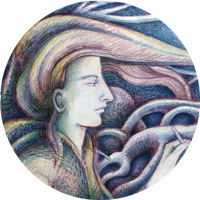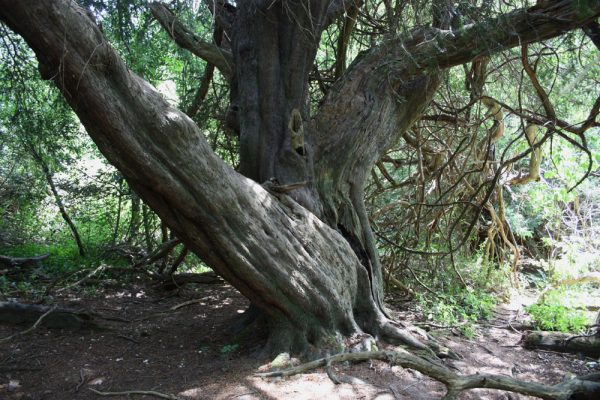
What comes first the tree or the book? The tree of course – there would be no books without trees. However, having just finished an altered book, Beneath the Old Tree, I was inspired to find a really large, old, real tree. So, I decided to pay another visit to Kingley Vale, just north-west of Chichester in West Sussex, which has an ancient yew forest. Some of the trees are thousands of years old. Each time I go there, I’m in awe of this wondrous, magical place.
In the forest it was hushed beneath the elephantine old yews. There were other people about – families – but their voices were muffled. Quiet and peaceful, the air was still, the forest floor was dappled by sunlight that streamed through the tangled spiralling branches.
Within this sanctuary are trees with enormous muscular girths and heavy limbs as smooth and hard as ivory; tusks descending to and disappearing into the dusty earth only to re-emerge nearby as offspring trees, creating a shambling, rhythmical cascade away from the main trunk. Each ancient yew stands within a fortress of these spidery, fluid limbs, each a powerful presence, deep, self-contained and stoic with a desire to reach out and touch the earth.
A bullfinch sounded in a hawthorn on the periphery of the grove, its sad note sung as though the bird was lost on the other side.
Some trees bear bark that is dry and peeling, others raw but smooth. As I ducked beneath each weighty limb, I felt the underside, polished by countless hands, rubbed to a shine by shoulders of both humans and deer.
Sitting within the hook of a limb, I felt safe and secure – anyone needing comfort should seek out a low tree to sit in.
Trunks fold into fissures and hollows, bulge with muscular growths. Some trees are whiskered by fresh, verdant shoots, others have openings like doorways or mouths frozen in silent song.
We came across a tree with its sides split, perhaps by lighning. Inside, the heartwood was deep arterial red. I picked up a square shard from the earth, a piece of the yew’s heart, to take home. Most of the trees bear wounds.
Some branches are algal green, elsewhere purplish pink, like the irridescent tip of a pheasant’s feather.

Little grows beneath a yew. They are both warm and inviting and brittle and repelling. A friend believes that here the yews talk to each other. She may be right.
After our amble in the groves, we emerged onto downland covered with chalkland flowers. Bees and butterflies busied around marjoram, birds foot trefoil and thyme-covered anthills in the bright sunshine. A roe deer leapt across the grassland and disappeared into the wooded hillside. Overhead a kite wheelled, it’s wings showing the gaps of its summer moult.
On returning home I wanted to create something in response to being in this forest. I decided to work in a looser, more carefree style and try out media I don’t usually use – chalk pastels and smudged penwork.

Below are some sketchbook drawings inspired by yews:


Perhaps it was fortunate that I missed the Hayward gallery exhibition Among the Trees because of the virus. I took this as an invitation to spend more time with real trees.

Back to my altered book. It’s of an old tree with a mass of roots within which hide a badger family. On deeper pages there is a squrrel, a fox and deer.










Your drawings and altered book works are so beautiful, Alexi! And thank you for the trip to the trees.
Thank you Gina! :) Your blog is as inspiring as ever :) Keep well x
Thanks for sharing. So beautiful. Do you sell any artwork of the Kingley Vale yew trees?